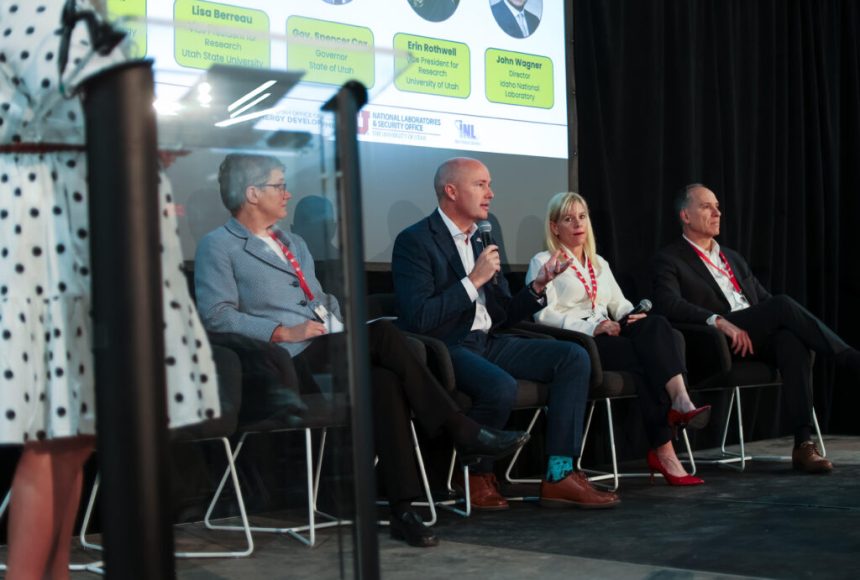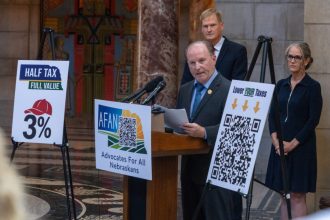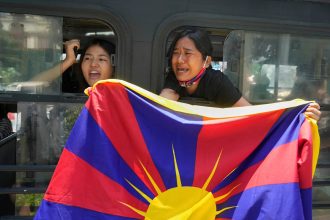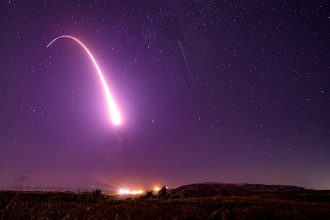Utah Gov. Spencer Cox speaks as part of a panel at the Utah Energy Week conference at the University of Utah on Tuesday, Sept. 16, 2025. (Courtesy of the Utah Governor’s Office)
Utah Gov. Spencer Cox said he’s hopeful about rural Utah’s odds of overcoming a tumultuous economic time in the midst of changing energy technologies and needs.
That’s because in the nuclear energy space, he notices the executive branches in other states sharing more consensus than disagreements. And, because of those areas’ existing transmission lines and infrastructure.
Rural counties like Emery and Carbon have attracted multiple energy companies, with facilities like the San Rafael Energy Lab, while in the Fillmore, Beaver and Milford area, geothermal projects and existing wind and solar farms are set to make up the Utah Renewable Energy Corridor, Cox said during a panel discussion at the Utah Energy Week conference at the University of Utah.
SUBSCRIBE: GET THE MORNING HEADLINES DELIVERED TO YOUR INBOX
“That’s where the opportunity lies, an opportunity to bring in jobs, an opportunity to bring in engineers and really talented people to help the people who are already there and to get them hope for a brighter future,” Cox said on Tuesday.
There’s still a challenge in convincing Utahns that implementing nuclear energy technologies in the state is a good idea. However, he said, polling on the issue has lately been “overwhelmingly positive.”
According to a recent poll from the Deseret News and the Hinckley Institute, 49% of Utahns are in favor of building small nuclear reactors in the state, while 31% are opposed to it and 19% remain undecided. That support has lowered from the 65% the pollsters recorded in 2023, in a survey that asked opinions on a nuclear power plant in the state.
With that broad consensus, Cox said, rural Utah has the potential to be benefitted and help ease the political divide in the state, since polarization is linked to the economy.
“People have felt left out of the new economy. It has left a big segment of our population behind and I can tell you, as someone from rural Utah, we really feel that deeply,” Cox said. “You don’t lose your job in a coal mine and become a coder overnight. That’s not how it works.”
The governor does foresee more job displacement with the emergence of artificial intelligence in urban areas and in white collar jobs.
Let us know what you think…
“Which is something we’ve never seen before,” Cox said. “So we’re at this very tumultuous time, anything we can do to reestablish economic certainty in the lives of people is going to what is going to make us healthier.”
John Wagner, director of the Idaho National Laboratory said during the panel that one of the biggest challenges of the 890-square-mile facility is recruiting — even more so if those jobs are in the lab’s nuclear operations since there hasn’t been much training in that area for a long time.
The Idaho Falls-based lab has grown to have about 6,400 employees. However, Wagner’s concern about the general energy development workforce remains, especially since thousands of workers are needed on site to build nuclear generators.
“Where are those folks going to come from to enable us to (achieve) our current administration goals to quadruple nuclear power by 2050?” Wagner said.
Cox agreed, describing the challenge as “terrifying,” adding that the state needs to also build more homes for the next generation of workers. But, he hopes the state’s higher education system will collaborate in a “universal effort” to encourage people to pursue technical paths.
“I think we made a huge mistake as a country in the way that we educate our young people. We’ve separated work from education for far too long. That education is the thing you do the first 20-plus years of your life, and then you get a job, you do that for the rest of your life,” Cox said. “That is not the way the economy works now. We have to get work earlier into education, and we have to get education later into work as we continue to learn new skills and have new opportunities.”









